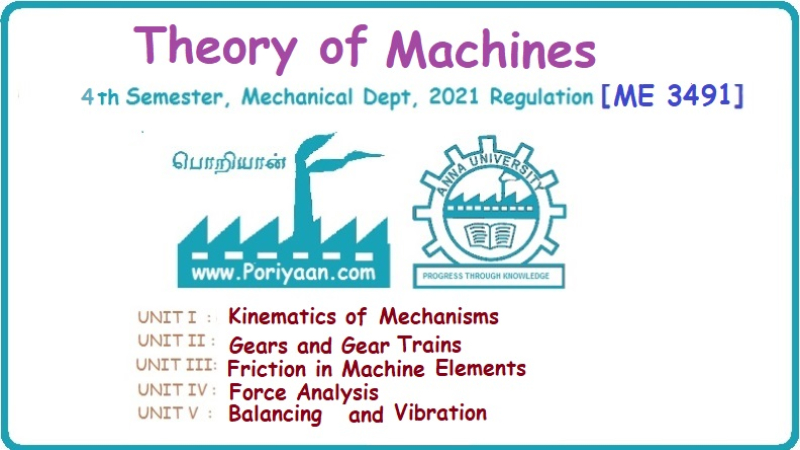Theory of Machines: Unit I: Kinematics of Mechanisms
Review Questions
Kinematics of Mechanisms - Theory of Machines
Explain the following terms: (a) Resistant body; (b) Kinematic link; (c) Kinematic pair; (d) Kinematic chain; and (e) Mechanism.
REVIEW QUESTIONS
1.
Explain the following terms: (a) Resistant body; (b) Kinematic link; (c)
Kinematic pair; (d) Kinematic chain; and (e) Mechanism.
2.
Differentiate between the following terms:
(a)
Resistant body and rigid body, (b) Machine and structure,
(b)
Machine and mechanism, and (c) Lower pair and higher pair.
3.
What do you mean by constrained motion? What are the different types of pairs
having constrained motion? Explain each type with examples and neat sketches.
[Hint:
Refer Section 1.4]
4.
Explain different kinds of kinematic pairs with examples.
5.
Derive the equation to determine the degree of freedom of a planar mechanism.
Prove that a cam-roller follower mechanism is an exception for the above
equation.
6.
Explain Kutzbach criterion for the mobility of a mechanism with suitable
example.
7.
Sketch and explain the inversion of a four-bar mechanism, all the four pairs
are turning pairs.
[A.U.,
Nov/Dec 2006; Nov/Dec 2011]
[Hint:
Refer Section 1.13]
8.
Sketch and describe the working of two different types of quick-return
mechanisms. Derive an expression for the ratio of time taken in forward and
return stroke for one of these mechanisms.
[A.U.,
Nov/Dec 2006]
[Hint:
Refer Sections 1.15.2.1 and 1.15.3.2]
9.
Sketch a slider-crank chain and its various inversions stating actual machines
which they are used in practice.
[A.U.,
May/June 2007; Nov/Dec 2010; Apr/May 2011; Nov/Dec 2012]
[Hint:
Refer Section 1.15]
10.
Explain with neat sketches and their kinematic differences, two different
inversions of a single slider-crank chain that can be used for the same
application in machine tools.
11.
Illustrate a crank and slotted lever mechanism as an inversion of single
slider-crank chain. Deduce an expression for length of stroke in terms of link
lengths.
12.
Sketch and explain Whitworth quick-return mechanism.
13.
Sketch and explain three inversions of a double slider-crank chain.
[A.U.,
Nov/Dec 2011; Nov/Dec 2013]
[Hint:Refer Section 1.17]
14.
Prove, with neat sketches, that an elliptical trammel can be used to trace many
ellipses and one circle.
Theory of Machines: Unit I: Kinematics of Mechanisms : Tag: : Kinematics of Mechanisms - Theory of Machines - Review Questions
Related Topics
Related Subjects
Theory of Machines
ME3491 4th semester Mechanical Dept | 2021 Regulation | 4th Semester Mechanical Dept 2021 Regulation
